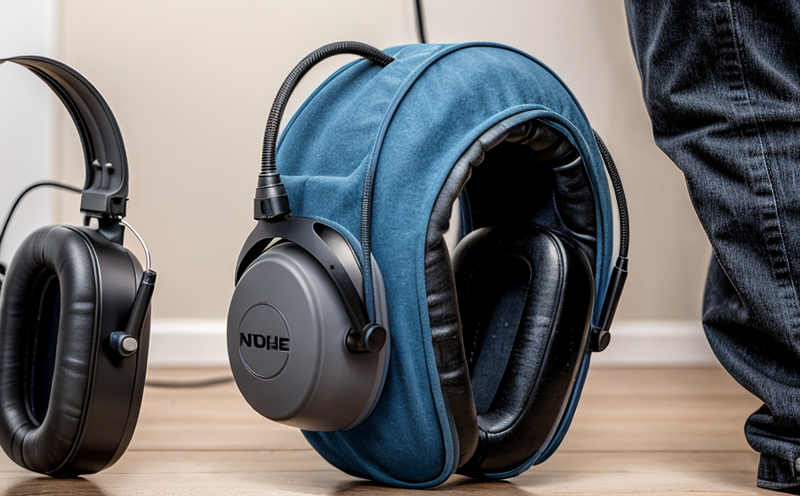EN 352-7 Level-Dependent Ear Muffs Testing
The EN 352 series of standards provides a framework for the testing and assessment of hearing protection devices (HPDs), including ear muffs. Specifically, EN 352-7:2019 focuses on level-dependent ear muffs, which are designed to provide varying degrees of attenuation based on the sound pressure levels present in different environments.
This standard is crucial for industries where workers may be exposed to fluctuating noise levels. Level-dependent ear muffs can offer a more efficient and comfortable fit by providing greater protection when necessary while allowing communication in quieter conditions. The testing procedure outlined in EN 352-7 ensures that the devices meet stringent performance criteria, thereby protecting workers from overexposure to hazardous noise.
The primary purpose of this service is to ensure that level-dependent ear muffs comply with the requirements set forth by EN 352-7. This involves a series of tests designed to evaluate the device’s ability to attenuate sound at specific decibel levels. The testing process includes:
- Fit Testing: Ensures that the ear muffs fit securely and comfortably, which is crucial for effective noise reduction.
- Attenuation Measurement: Evaluates the amount of sound reduction provided by the ear muffs at various decibel levels. This includes both low-level and high-level attenuation tests to ensure consistent performance across different noise environments.
- Communication Performance: Checks how well the ear muffs allow for effective communication in noisy environments, as they are designed with a communication port or similar feature.
The testing process is rigorous and involves precise measurement techniques. The devices are subjected to controlled sound environments where their performance is recorded against predefined standards. This ensures that any product certified under this standard meets the highest levels of safety and effectiveness required by occupational health and safety regulations worldwide.
For quality managers, compliance officers, R&D engineers, and procurement teams, ensuring adherence to these standards is critical for maintaining a safe work environment. By partnering with a laboratory specializing in such testing, organizations can guarantee that their hearing protection devices comply fully with the relevant international standards.
Applied Standards
The EN 352 series is part of a broader set of European standards for hearing protectors. These standards are designed to ensure consistency and comparability in the performance evaluation of HPDs across different manufacturers and regions. EN 352-7:2019 specifically addresses level-dependent ear muffs, which have become increasingly popular due to their ability to adapt to varying noise levels.
The standard specifies detailed procedures for testing these devices, including:
- Fit and comfort assessment
- Sound attenuation measurement at different decibel levels
- Evaluation of communication performance in noisy environments
By adhering to this standard, manufacturers can ensure that their products meet the highest safety and effectiveness requirements. This not only protects workers but also enhances productivity by reducing hearing loss due to prolonged exposure to high noise levels.
Industry Applications
The application of level-dependent ear muffs is extensive across various sectors where noise hazards are prevalent. These include:
- Manufacturing: Workers in factories, particularly those involved in metalworking or woodworking, often face high levels of noise.
- Mining: Miners working underground encounter both machinery-generated and natural noises that can be extremely hazardous to hearing health.
- Construction: Construction sites are notorious for producing loud sounds from various sources such as heavy equipment and power tools.
- Transportation: Employees in ports, airports, or railway stations frequently experience high noise levels due to the operation of large machinery and vehicles.
In these industries, the ability of level-dependent ear muffs to adapt to varying noise levels makes them an essential component of a comprehensive safety strategy. By providing effective protection when needed while allowing for clear communication in quieter environments, these devices play a critical role in maintaining worker health and productivity.
Environmental and Sustainability Contributions
The use of level-dependent ear muffs contributes positively to both environmental sustainability and safety. By ensuring that workers are protected from excessive noise, these devices help prevent the development of hearing impairments, which can lead to increased medical costs and reduced workforce productivity.
In addition, the design of these ear muffs is often optimized for comfort and efficiency, reducing the need for multiple sets of HPDs in different environments. This not only enhances worker satisfaction but also contributes to overall environmental sustainability by minimizing waste.
Furthermore, compliance with standards like EN 352-7 ensures that hearing protection devices are manufactured using environmentally friendly practices and materials where possible. This aligns with broader corporate sustainability goals, promoting a safer and more sustainable work environment for all.





